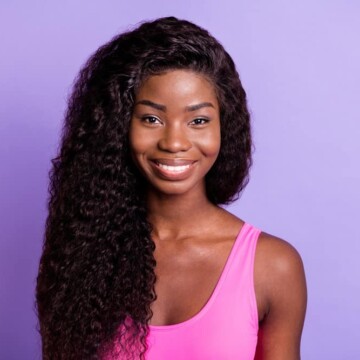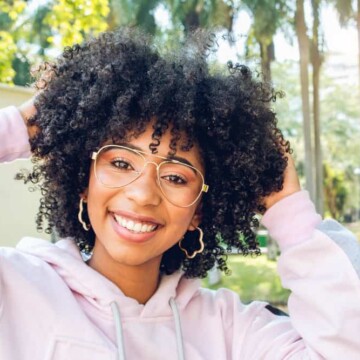
Making the decision to start locs is a big deal, especially in light of the challenges many that people face during their locs journey. You need to be aware of all of the loc stages before you start your locs, so you'll be prepared for the journey.
In this article, we'll inform you of the 5 different stages of locs, how long each stage lasts, and how to care for your locs throughout each stage.
Table of Contents
The 5 Different Stages of Locs
In this video, Alexis Harris describes the 5 different stages of locs, from starter locs to more mature locs, and includes several pictures.
Stage 1: Starter Locs/Baby Stage
The first stage is the starter stage (also called the baby stage or the starter phase). It starts right when you twist, comb coil, or interlock your hair for the first time.
Your locs are newborns, and depending on how you started them, they may be fragile. It's in this stage that many people quit, and that's because your locs may shrink up, frizz out, and require more care than you expected.

How Long Does it Last?
The starter loc stage lasts anywhere from a few months to 6 months on average. The length of time this stage will last for you may differ from the next person, depending on your hair type and how you care for your locs.
How to Care for Baby Locs
Caring for baby locs can be challenging, especially if this is your first set of locs. If your locs are in the baby loc stage, you shouldn't pass on these tips:
- Try not to manipulate your locs too much. That means try not to touch them unless it’s necessary. Also, only retwist every 4 to 6 weeks (or interlock every eight weeks).
- Wash your hair and scalp every couple of weeks or so with a natural shampoo. There’s no need to put off washing for months. If you use heavy gels or waxes (which we don’t recommend), make sure to use a clarifying shampoo to ward off buildup. Be gentle when washing so as not to unravel your locs.
- Keep product usage to a minimum. When you retwist, use light oils, creams, and gels (or nothing but water). The less product, the better! This helps to minimize product buildup and weighed-down locs.
- Avoid conditioner. Conditioning your starter locs could cause them to unravel. In some cases, they could leave buildup on your hair, which could become embedded in your locs.

Stage 2: Budding Stage
Once you make it past the starter loc stage, your locs will enter the budding stage. The budding stage is characterized by frizziness, visible bumps on your locs, and a whole lot of unruliness.
Many don't like their locs when they're in the budding stage since they may look a bit unkempt at times, but it's all part of the process!
How Long Does it Last?
The budding stage lasts anywhere from month 6 to month 12. You could experience budding at the ends, middle, or closer to the roots of your locs.
There's no telling how long the budding stage will last for you since your hair care routine, hair length, and hair texture all play a role. If you have super long locs, your budding stage could last longer than six months - even closer to a year.
How to Care for Budding Locs
Caring for budding locs is not too different from caring for baby locs, except for the fact that you don't have to worry as much about unraveling. You'll need to wash and maintain your locs as needed and be on the lookout for buildup.
You may be tempted to retwist or interlock your hair more often to make it look neater, but we urge you to stick to your regular loc maintenance routine.
Retwisting or interlocking too often could lead to scalp pain, abrasions, traction alopecia, and thinning at the roots of your locs. So, do your best to make peace with your locs in this stage.

Stage 3: Teenage Stage
The teenage stage of locs is characterized by awkwardness. During this stage of loc maturation, your locs may act like teenagers, doing precisely what you don't want them to.
But the positive part of the teenage stage is that your locs will begin to take shape, becoming thicker and rounder than they started.
How Long Does It Last?
The teenage stage lasts anywhere from month 12 to month 18. Just like the other stages, there's no definitive amount of time this stage will last.
For some, the teenage stage only lasts a few months, while others will deal with it for closer to a year. If your locs have been in the teenage stage for what seems like forever, it'll be over soon enough!
How to Care for Locs in the Teenage Stage
By this point, you probably have a regular loc routine that works for you. Continue with your normal loc care routine, and you'll get to the next stage soon.
You may be preoccupied with how your locs are looking in the teenage stage. One way to deal with this is to experiment with loc styles. Pull your locs up into a high ponytail, do a side braid, try loc petals - the options are endless.

Stage 4: Mature Stage
The mature stage of locs is a favorite of many. It's the stage where your locs turn a corner and begin to look smoother and more cylindrical.
Your roots will not be as unruly, and you won't need to retwist or interlock as often as you did in the previous stages. So, your loc maintenance routine will get much easier.
How Long Does it Last?
The mature stage usually lasts from 15 months to 18 months. But, for some, it may start or end earlier or later.
Caring For Locs in the Mature Stage
Caring for locs in the mature stage is easier than caring for teenage locs because your locs will behave much more during this stage. Keep your locs clean, conditioned, and moisturized so that they'll continue to flourish.
Be careful about getting lax with your loc regimen - you may be tempted to do so since your locs have some hang time and are behaving.

Stage 5: Rooted Stage
The final stage of locs is the Rooted stage, where your locs will take on a slightly skinnier profile and get a little more weighty. They'll hang down and sway when you walk. Your used-to-be loc babies are now adults, and they behave as such.
How Long Does it Last?
The rooted stage starts around 18 months and continues indefinitely. Once you hit this stage, you're home-free!
Caring for Locs in the Rooted Stage
In the rooted stage, you should continue doing what you were doing up until this point to care for your locs. So long as you do that, your locs will grow leaps and bounds.
Note: Some locs may mature faster than others. You're more likely to have locs in multiple stages at once if you have several different hair textures. Also, the looser your curls are, the longer they may take to loc (not in all cases).
- Methods To Start Locs
- Palm Rolling and Interlocking
- Starting Locs with Two Strand Twists
- Sisterlocks Technique
Freeform Loc Stages
Freeform locs are allowed to mature freely without retwisting, interlocking, or otherwise maintaining the new growth. For this reason, some people think that freeform locs mature faster than other loc types.
But there is no concrete evidence that freeform locs mature at a different rate than locs maintained with retwisting or interlocking.
If you didn't know before, now you know that there are several stages to locs, and every stage is marked by new and exciting changes.
If you're in a problematic loc stage and wondering when it's going to be over, you've now got some answers.
There will be failures and successes throughout your loc journey, but we guarantee it'll all be worth it in the end! If you decide that you're not ready for freeform locs, you can always try installing faux locs for a temporary style change. Good luck!




